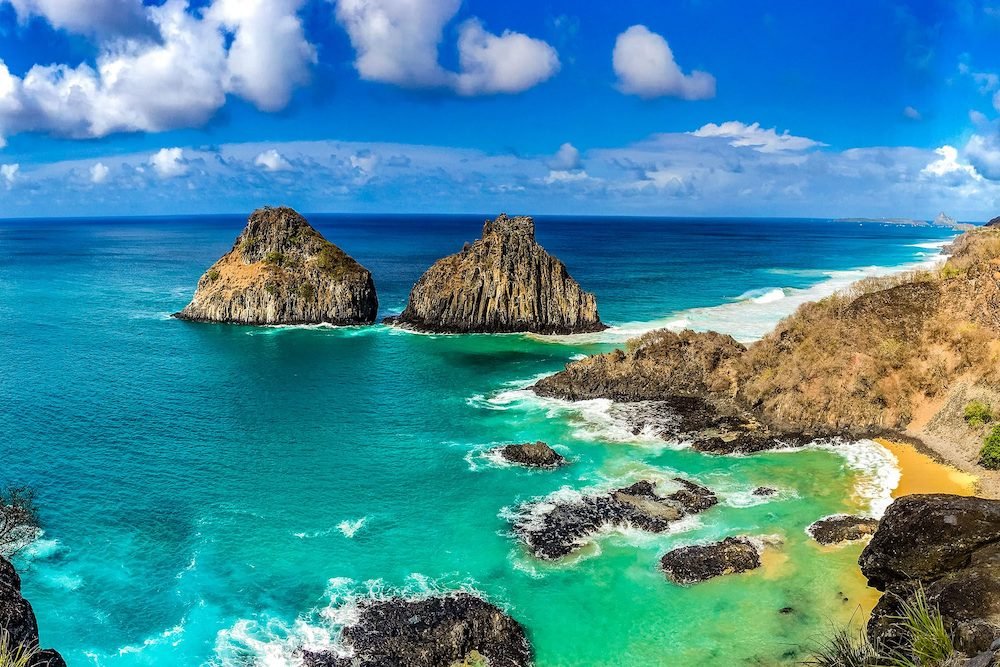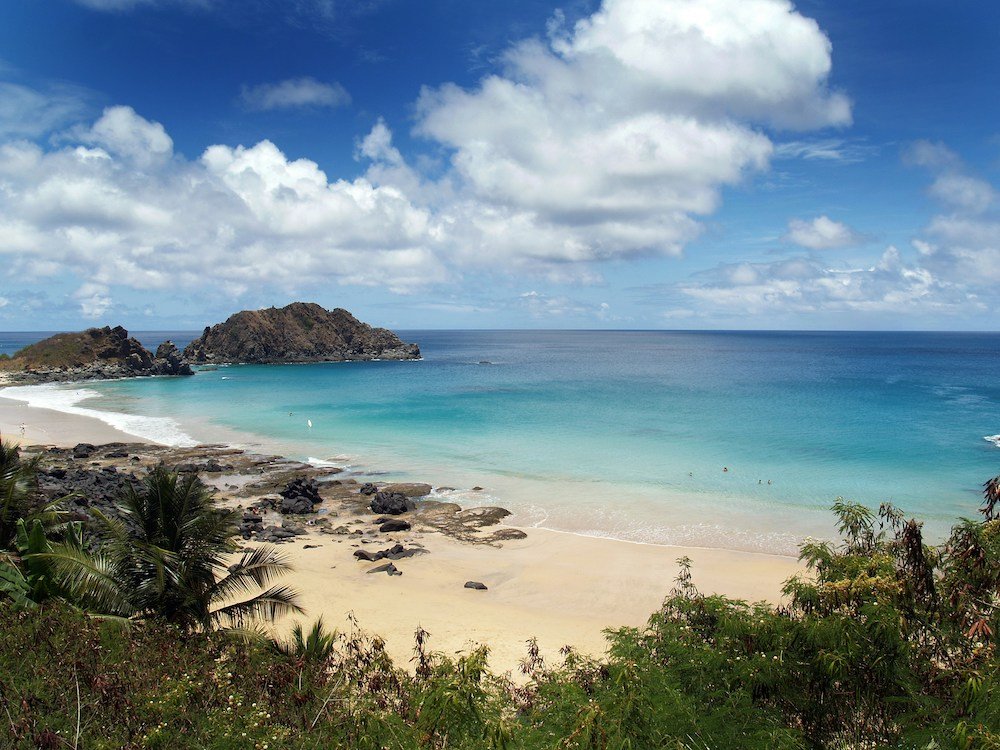
Nestled off the northeastern coast of Brazil lies the captivating archipelago of Fernando de Noronha.
Renowned for its pristine beaches, crystalline waters, and rich marine life, Fernando de Noronha stands as a beacon of natural beauty and ecological diversity.
In this section, we will provide a brief overview of Fernando de Noronha’s location, significance, and the island’s unparalleled attractions.
Fernando de Noronha is an archipelago composed of 21 islands and islets situated approximately 350 kilometers (217 miles) off the coast of Brazil’s Pernambuco state.
Declared a UNESCO World Heritage Site in 2001, this remote paradise spans an area of around 26 square kilometers (10 square miles) and is renowned for its pristine marine ecosystems and unique biodiversity.
Originally discovered by Portuguese explorers in the 16th century, Fernando de Noronha has a storied past, serving as a strategic outpost, a penal colony, and now, a protected marine park.
Its isolation from the mainland has preserved its natural splendor, making it a haven for ecotourism and conservation efforts.
Fernando de Noronha’s allure lies in its breathtaking landscapes and vibrant underwater ecosystems.
With its picture-perfect beaches, towering cliffs, and emerald-green waters, the archipelago offers visitors a glimpse of paradise on Earth. Some of its most iconic natural attractions include:
1. Pristine Beaches:
From the powdery sands of Baía do Sancho to the secluded coves of Praia do Leão, Fernando de Noronha boasts some of the world’s most beautiful beaches.
Each beach exudes its own unique charm, offering opportunities for swimming, sunbathing, and snorkeling amidst stunning coastal scenery.
2. Marine Life:
The surrounding waters of Fernando de Noronha teem with marine life, making it a haven for snorkelers and divers alike.
Visitors can encounter a kaleidoscope of underwater wonders, including colorful reef fish, sea turtles, octopuses, and even dolphins.
The island’s marine park status ensures the protection of its fragile ecosystems, allowing for unforgettable encounters with nature.
3. Dramatic Landscapes:
Beyond its idyllic beaches, Fernando de Noronha boasts rugged terrain and dramatic vistas that beckon adventurers to explore.
Whether trekking along scenic trails, scaling rocky cliffs, or admiring panoramic views from Mirante dos Golfinhos, the island offers countless opportunities for outdoor exploration and discovery.
In the following sections, we will delve deeper into the enchanting attractions and experiences that await visitors to Fernando de Noronha, providing insights into planning the perfect island getaway and immersing oneself in its unparalleled natural beauty.
Planning Your Trip

Best time to visit Fernando de Noronha
Determining the ideal time to visit Fernando de Noronha depends largely on personal preferences and desired experiences.
However, the archipelago experiences two distinct seasons: the dry season and the rainy season.
During the dry season, which typically runs from September to March, visitors can expect sunny weather and calm seas, making it an ideal time for outdoor activities such as snorkeling, diving, and beach exploration.
The months of October to December are particularly popular due to warmer temperatures and clearer visibility for underwater activities.
Conversely, the rainy season, spanning from April to August, brings occasional showers and rougher seas, though it also offers unique opportunities for birdwatching and enjoying the island’s lush green landscapes.
How to get to Fernando de Noronha (flights, boats, etc.)
The primary mode of transportation to Fernando de Noronha is by air.
The archipelago is served by regular flights departing from major cities in Brazil, including Recife and Natal.
The main carrier operating flights to Fernando de Noronha is Gol Linhas Aéreas.
It’s important to note that Fernando de Noronha has a strict environmental preservation policy, which includes limitations on the number of visitors allowed on the island at any given time.
As a result, flight availability can be limited, especially during peak tourist seasons. It’s advisable to book flights well in advance to secure your travel arrangements.
Boat trips to Fernando de Noronha are rare and not typically recommended due to the long duration of the journey and unpredictable sea conditions.
Entry requirements and permits for visiting the island
Visitors to Fernando de Noronha are required to pay an Environmental Preservation Tax (TAXA) upon arrival.
The tax amount varies depending on the length of stay and is subject to change. Additionally, visitors must present a valid passport or Brazilian identification card upon arrival.
It’s essential to check the latest entry requirements and visa regulations, especially for international travelers, as they may vary depending on your country of origin.
Accommodation options (hotels, guesthouses, etc.) and booking tips
Fernando de Noronha offers a range of accommodation options to suit different preferences and budgets.
From luxurious resorts to cozy guesthouses and hostels, visitors can find accommodations that cater to their needs.
It’s advisable to book accommodation well in advance, especially during peak tourist seasons, to secure your preferred choice.
Many accommodations offer packages that include activities such as diving excursions or island tours, providing added value for visitors.
Budgeting and cost considerations
Fernando de Noronha is known for its natural beauty and unique experiences, but it’s essential to budget accordingly for your trip.
The cost of living on the island can be higher compared to mainland Brazil due to transportation costs, limited resources, and environmental preservation efforts.
In addition to accommodation and transportation expenses, visitors should budget for meals, activities, and souvenirs.
While some attractions, such as beaches and hiking trails, are free to access, others may require payment of entrance fees or tour fees.
By planning ahead and budgeting wisely, visitors can make the most of their time on Fernando de Noronha while ensuring a memorable and enjoyable experience.
Exploring the Islands
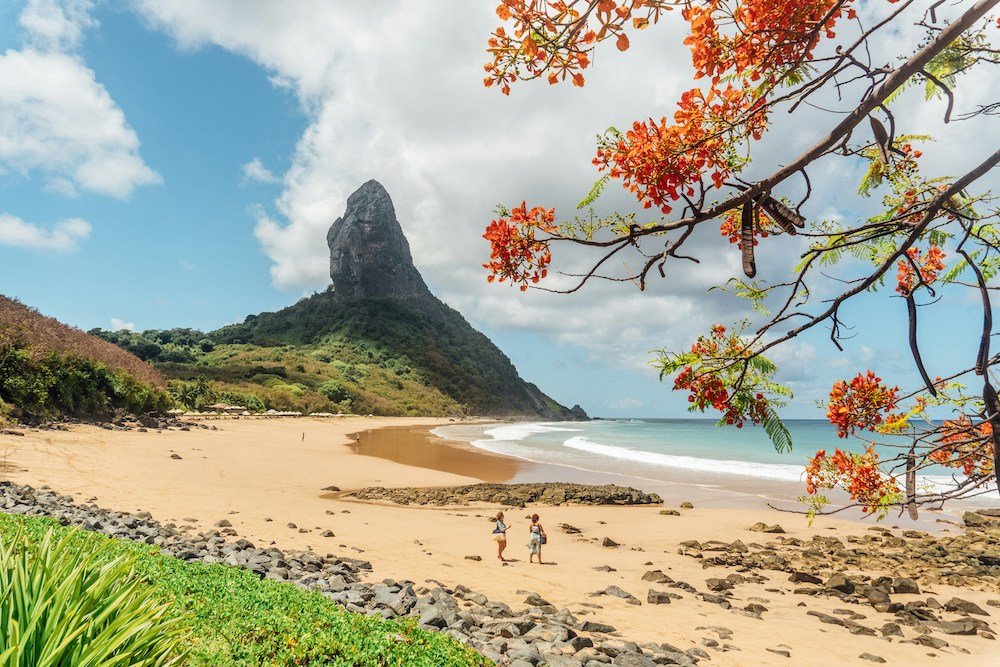
Fernando de Noronha offers a myriad of attractions and activities that cater to nature lovers, adventure seekers, and culture enthusiasts alike. Here’s an overview of some of the island’s main highlights:
Beaches:
- Baía do Sancho: Frequently ranked among the world’s best beaches, Baía do Sancho entices visitors with its pristine sands, turquoise waters, and stunning cliffs.
- Praia do Leão: Known for its crescent-shaped bay and nesting site for sea turtles, Praia do Leão offers serene surroundings and excellent opportunities for wildlife observation.
- Praia do Sueste: Ideal for snorkeling, Praia do Sueste is home to a diverse array of marine life, including sea turtles, rays, and colorful fish.
Diving and Snorkeling:
- The crystal-clear waters surrounding Fernando de Noronha provide unparalleled visibility for diving and snorkeling enthusiasts. Popular dive sites include Morro de Fora, Pedras Secas, and Buraco das Cabras, where divers can explore vibrant coral reefs and encounter a variety of marine species.
Hiking and Nature Trails:
- Exploring Fernando de Noronha’s rugged terrain and lush landscapes is a must-do for outdoor enthusiasts. Hiking trails such as the Atalaia Trail and the Capim-Açu Trail offer panoramic vistas of the island’s coastline, while the Parnamarim Fort Trail provides insights into the region’s historical heritage.
Recommended itineraries for different lengths of stay
Whether you’re planning a short getaway or an extended vacation, Fernando de Noronha offers a range of itineraries to suit various interests and timeframes:
3-Day Itinerary:
- Day 1: Explore the island’s northern beaches, including Baía do Sancho and Praia do Leão.
- Day 2: Embark on a snorkeling or diving excursion to discover the island’s vibrant underwater ecosystems.
- Day 3: Visit historical landmarks such as the Parnamarim Fort and enjoy sunset views from Mirante dos Golfinhos.
7-Day Itinerary:
- Days 1-3: Follow the highlights of the 3-day itinerary, then spend additional time exploring secluded beaches and hiking trails.
- Days 4-7: Participate in guided tours, boat trips, and cultural experiences to gain a deeper understanding of Fernando de Noronha’s natural and cultural heritage.
Transportation options on the island (renting bikes, taxis, etc.)
Getting around Fernando de Noronha is relatively easy, thanks to a variety of transportation options available to visitors:
Rental Bikes:
- Renting a bike is a popular and eco-friendly way to explore the island’s attractions at your own pace. Several rental shops offer bicycles for daily or weekly rates, allowing you to navigate Fernando de Noronha’s roads and trails with ease.
Taxis and Transfers:
- Taxis are readily available on the island and provide convenient transportation between accommodations, beaches, and other points of interest. Additionally, many hotels and guesthouses offer shuttle services and airport transfers for their guests’ convenience.
Guided Tours:
- For those seeking a hassle-free way to explore Fernando de Noronha’s highlights, guided tours and excursions are an excellent option. Local tour operators offer a variety of tours, including island-hopping boat trips, off-road adventures, and cultural experiences led by knowledgeable guides.
With these transportation options at your disposal, navigating Fernando de Noronha’s scenic landscapes and attractions becomes an enjoyable and memorable experience.
Beaches and Natural Wonders

Fernando de Noronha boasts an array of stunning beaches, each offering its own unique charm and natural beauty.
Here are some of the most picturesque beaches that should not be missed during your visit:
1. Baía do Sancho:
- Frequently hailed as one of the world’s most beautiful beaches, Baía do Sancho captivates visitors with its pristine sands, turquoise waters, and dramatic cliffs. Accessible via a scenic trail or by boat, this secluded bay offers excellent swimming, snorkeling, and sunbathing opportunities.
2. Praia do Leão:
- Named after the iconic lion-shaped rock formation that overlooks its shores, Praia do Leão is a haven for nature enthusiasts and sea turtle enthusiasts. Visitors can witness the nesting and hatching of sea turtles during the nesting season (December to June) and enjoy the beach’s tranquil ambiance year-round.
3. Praia do Atalaia:
- Known for its natural pools teeming with colorful marine life, Praia do Atalaia is a snorkeler’s paradise. Access to this unique beach is restricted to protect its fragile ecosystems, so visitors must join guided tours organized by the national park.
Information on snorkeling and diving spots
Fernando de Noronha’s crystal-clear waters and vibrant marine ecosystems make it a premier destination for snorkeling and diving enthusiasts.
Here are some of the top spots for underwater exploration:
1. Morro de Fora:
- Located off the western coast of Fernando de Noronha, Morro de Fora offers impressive coral formations, underwater caves, and diverse marine species. Advanced divers can explore depths of up to 40 meters (131 feet) while encountering schools of colorful fish, turtles, and even sharks.
2. Pedras Secas:
- Situated near the Baía dos Porcos, Pedras Secas is renowned for its towering rock formations and thriving marine life. Divers can navigate through underwater canyons and crevices while marveling at the abundance of reef fish, moray eels, and octopuses that inhabit the area.
3. Buraco das Cabras:
- Translating to “Goat’s Hole,” Buraco das Cabras is a submerged cave system characterized by its labyrinthine passages and caverns. Divers can explore the depths of this unique underwater landscape while encountering fascinating geological formations and marine species.
Wildlife encounters (dolphins, turtles, etc.)
Fernando de Noronha is renowned for its rich biodiversity and abundant wildlife, offering visitors unparalleled opportunities for wildlife encounters. Here are some of the island’s most iconic inhabitants:
1. Dolphins:
- The waters surrounding Fernando de Noronha are home to spinner dolphins, which can often be spotted frolicking in the waves or performing acrobatic displays near the island’s coastline. Visitors can embark on dolphin-watching tours to observe these graceful creatures in their natural habitat.
2. Sea Turtles:
- Fernando de Noronha serves as a critical nesting site for several species of sea turtles, including green turtles and hawksbill turtles. During the nesting season (December to June), visitors can witness the remarkable sight of female turtles returning to the shore to lay their eggs, while hatchlings emerge from their nests and make their journey to the sea.
3. Marine Birds:
- The island is also home to a diverse array of marine birds, including frigatebirds, boobies, and terns. Birdwatchers can explore the island’s coastal cliffs and nesting sites to observe these magnificent birds in their natural habitat.
Encounters with dolphins, sea turtles, and marine birds are just a few of the unforgettable wildlife experiences that await visitors to Fernando de Noronha, offering a deeper appreciation for the island’s natural wonders and ecological diversity.
Cultural and Historical Sites
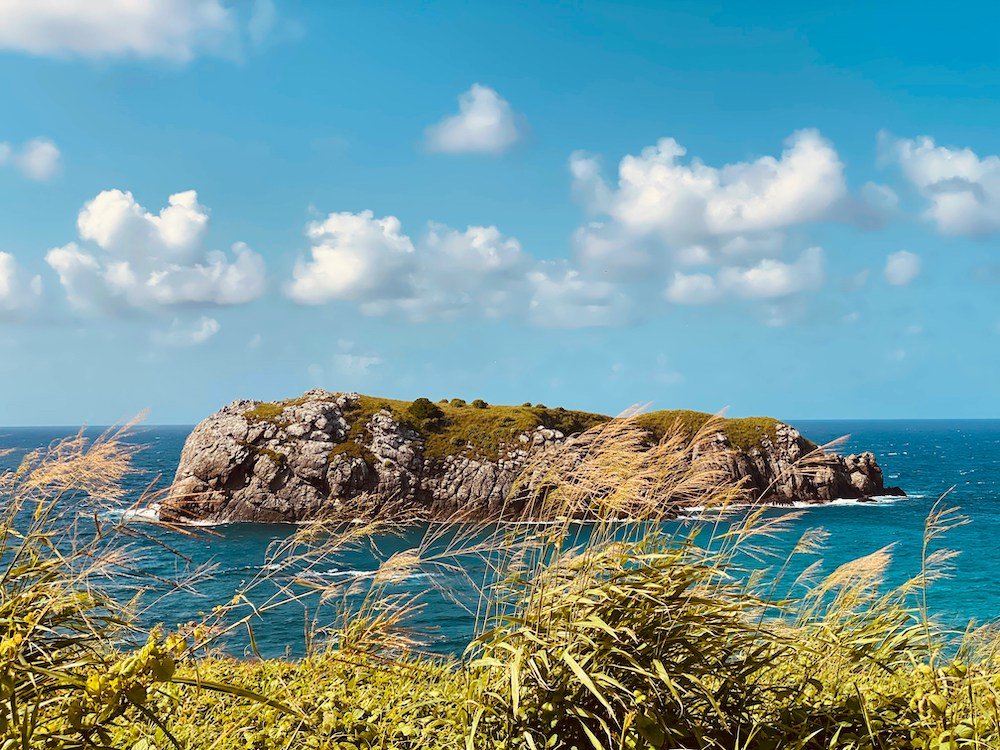
Fernando de Noronha’s allure extends beyond its natural beauty to encompass a rich tapestry of cultural and historical heritage.
Immerse yourself in the island’s vibrant past and indigenous traditions through its captivating landmarks, local communities, and guided experiences.
Overview of historical landmarks and cultural attractions
Explore Fernando de Noronha’s historical landmarks and cultural attractions, each offering insights into the island’s storied past and cultural significance:
1. Fortaleza Nossa Senhora dos Remédios:
- Dating back to the 18th century, Fortaleza Nossa Senhora dos Remédios stands as a testament to the island’s colonial history. This well-preserved fortress served as a strategic defense outpost against pirate attacks and foreign invasions, offering panoramic views of the surrounding coastline and sea.
2. Museu do Tubarão (Shark Museum):
- Located in the heart of Fernando de Noronha, the Museu do Tubarão showcases a fascinating collection of shark specimens and marine artifacts. Visitors can learn about the island’s marine ecosystems, conservation efforts, and the role of sharks in the local ecology through interactive exhibits and educational programs.
3. Vila dos Remédios:
- Wander through the cobblestone streets of Vila dos Remédios, Fernando de Noronha’s charming historic district. Here, you’ll find colonial-era buildings, quaint churches, and local artisan shops offering handmade crafts and souvenirs. Don’t miss the opportunity to sample traditional Brazilian cuisine at one of the area’s cozy cafes or restaurants.
Indigenous heritage and local communities
Discover Fernando de Noronha’s indigenous heritage and vibrant local communities, which contribute to the island’s cultural diversity and sense of identity:
1. Quilombo dos Palmares:
- Pay homage to the legacy of Quilombo dos Palmares, a historic settlement founded by escaped African slaves in the 17th century. Today, the site serves as a symbol of resistance and cultural pride, hosting cultural events, traditional ceremonies, and educational programs that celebrate Afro-Brazilian heritage and traditions.
2. Local Artisans and Craftsmen:
- Engage with local artisans and craftsmen who specialize in traditional handicrafts and indigenous artwork. From intricately woven baskets and pottery to vibrant paintings and sculptures, Fernando de Noronha’s artisans showcase the island’s cultural heritage and artistic prowess through their creations.
Recommended tours and guided experiences
Embark on immersive tours and guided experiences that offer deeper insights into Fernando de Noronha’s cultural and historical significance:
1. Historical Walking Tours:
- Join knowledgeable guides on historical walking tours of Vila dos Remédios and Fortaleza Nossa Senhora dos Remédios, exploring the island’s colonial-era architecture, landmarks, and hidden gems.
2. Indigenous Cultural Experiences:
- Participate in indigenous cultural experiences and workshops that highlight traditional rituals, music, dance, and culinary practices of the island’s native inhabitants.
3. Ecotourism and Conservation Programs:
- Engage in ecotourism and conservation programs led by local organizations and environmental groups, participating in beach cleanups, reef monitoring, and wildlife conservation initiatives that promote sustainable tourism and protect Fernando de Noronha’s natural resources.
Immerse yourself in Fernando de Noronha’s cultural tapestry and historical legacy through its captivating landmarks, indigenous heritage, and immersive guided experiences, forging meaningful connections with the island’s past and present.
Dining and Cuisine

Indulge in the vibrant flavors and culinary delights of Brazilian cuisine during your visit to Fernando de Noronha.
From savory seafood dishes to tropical fruits and traditional delicacies, the island offers a feast for the senses that celebrates its rich cultural heritage and coastal bounty.
Introduction to Brazilian cuisine and local specialties
Brazilian cuisine is a melting pot of diverse influences, reflecting the country’s multicultural heritage and regional diversity.
At the heart of Brazilian culinary tradition are bold flavors, fresh ingredients, and time-honored cooking techniques that celebrate the bounty of the land and sea.
Local Specialties:
- Moqueca: A flavorful seafood stew made with fresh fish, shrimp, coconut milk, tomatoes, and spices, simmered to perfection and served with rice and farofa (toasted cassava flour).
- Tapioca: A traditional Brazilian snack made from cassava flour, tapioca is often filled with sweet or savory fillings such as cheese, coconut, or condensed milk.
- Feijoada: Considered Brazil’s national dish, feijoada is a hearty black bean stew made with pork, sausage, and smoked meats, accompanied by rice, collard greens, and farofa.
Recommended restaurants and dining experiences on the island
Experience the best of Fernando de Noronha’s culinary scene at these acclaimed restaurants and dining establishments, where fresh ingredients and innovative flavors take center stage:
1. Mergulhão:
- Nestled in the heart of Vila dos Remédios, Mergulhão offers an intimate dining experience with panoramic views of the ocean. Indulge in fresh seafood dishes, grilled meats, and Brazilian classics, accompanied by handcrafted cocktails and fine wines.
2. Varanda:
- Located near Praia do Cachorro, Varanda is renowned for its laid-back ambiance and delectable cuisine. Enjoy alfresco dining on the restaurant’s terrace, savoring mouthwatering seafood platters, tropical cocktails, and homemade desserts.
3. O Pico:
- Perched atop a scenic hillside overlooking Fernando de Noronha’s coastline, O Pico combines breathtaking views with gourmet cuisine. Feast on locally sourced ingredients, innovative dishes, and seasonal specialties, accompanied by an extensive wine list and attentive service.
Dietary options and considerations for visitors
Fernando de Noronha’s culinary scene caters to a variety of dietary preferences and restrictions, ensuring that all visitors can enjoy a memorable dining experience:
Vegetarian and Vegan Options:
- Many restaurants on the island offer vegetarian and vegan-friendly dishes made with fresh produce, grains, and plant-based ingredients. Look for menu items such as salads, vegetable stir-fries, and vegetarian pasta dishes.
Gluten-Free and Allergen-Friendly Choices:
- Restaurants are increasingly aware of dietary restrictions and offer gluten-free and allergen-friendly options for diners with specific dietary needs. Be sure to inform restaurant staff of any allergies or dietary restrictions when placing your order.
Fresh Fruits and Juices:
- Embrace the abundance of tropical fruits and juices available on the island, including mangoes, papayas, passion fruits, and acerolas. Enjoy refreshing fruit juices, smoothies, and açai bowls made with locally sourced ingredients.
Experience the vibrant flavors and culinary traditions of Brazil during your stay in Fernando de Noronha, savoring the island’s diverse cuisine and indulging in memorable dining experiences that celebrate its rich cultural heritage and coastal bounty.
Sustainable Tourism and Conservation Efforts
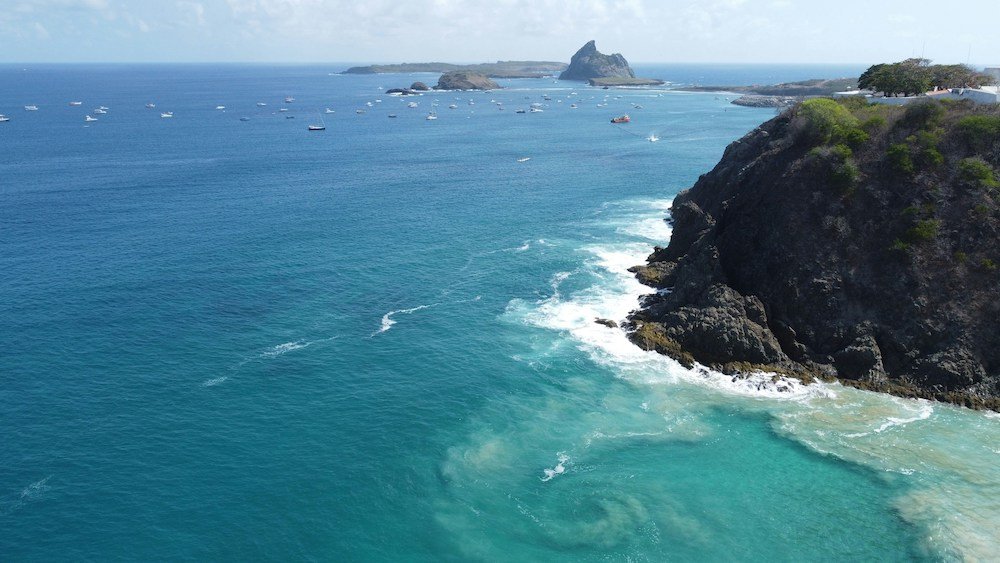
Fernando de Noronha is not only a paradise for travelers seeking natural beauty but also a stronghold for environmental conservation and sustainable tourism practices.
Discover the island’s commitment to preserving its delicate ecosystems and marine biodiversity, and learn how visitors can contribute to its conservation efforts.
Overview of environmental protection initiatives on Fernando de Noronha
Fernando de Noronha has implemented a range of environmental protection initiatives aimed at preserving its pristine landscapes and fragile ecosystems:
Marine Protected Area:
- Designated as a Marine National Park in 1988 and subsequently declared a UNESCO World Heritage Site in 2001, Fernando de Noronha is committed to protecting its marine biodiversity and coral reefs. Strict regulations govern fishing activities, water sports, and commercial development within the park boundaries, ensuring the long-term conservation of its natural resources.
Waste Management and Recycling Programs:
- The island has implemented comprehensive waste management and recycling programs to minimize environmental impact and promote sustainable practices among residents and visitors. Recycling facilities and collection points are available throughout the island, encouraging responsible waste disposal and resource conservation.
Renewable Energy Initiatives:
- Fernando de Noronha is embracing renewable energy solutions to reduce its reliance on fossil fuels and mitigate carbon emissions. Solar panels, wind turbines, and other renewable energy technologies are being implemented to power homes, businesses, and infrastructure, contributing to the island’s sustainability goals.
Responsible tourism practices and guidelines for visitors
As stewards of Fernando de Noronha’s natural heritage, visitors are encouraged to adopt responsible tourism practices and adhere to guidelines that minimize their environmental footprint:
Respect Nature and Wildlife:
- Observe wildlife from a safe distance and refrain from feeding, touching, or disturbing animals in their natural habitats. Follow designated trails and abide by park regulations to protect sensitive ecosystems and nesting sites.
Reduce, Reuse, Recycle:
- Minimize waste generation by opting for reusable water bottles, eco-friendly products, and biodegradable packaging. Dispose of trash responsibly in designated bins and recycling facilities, and avoid single-use plastics that can harm marine life and pollute the environment.
Conserve Water and Energy:
- Practice water conservation measures, such as taking shorter showers, turning off lights and appliances when not in use, and using energy-efficient technologies to reduce energy consumption. Respect local water resources and adhere to water usage guidelines established by conservation authorities.
Opportunities for volunteering and supporting local conservation efforts
Visitors can actively participate in conservation efforts and contribute to the protection of Fernando de Noronha’s natural resources through volunteering and community engagement:
Beach Cleanups and Conservation Projects:
- Join organized beach cleanups, reef monitoring programs, and conservation projects led by local organizations and environmental groups. Participate in hands-on activities that promote marine conservation, habitat restoration, and sustainable development initiatives.
Support Local Conservation Organizations:
- Donate to local conservation organizations and NGOs dedicated to preserving Fernando de Noronha’s biodiversity and cultural heritage. By supporting grassroots initiatives and community-based projects, visitors can make a meaningful impact and help safeguard the island’s natural treasures for future generations.
Ecotourism and Responsible Travel:
- Choose eco-friendly accommodations, tour operators, and businesses that prioritize sustainability and responsible tourism practices. Seek out eco-certified tours and experiences that promote environmental awareness, cultural immersion, and respect for local communities.
By embracing sustainable tourism principles and actively engaging in conservation efforts, visitors can play a vital role in protecting Fernando de Noronha’s natural beauty and ensuring its long-term sustainability as a premier ecotourism destination.
Practical Tips and Advice
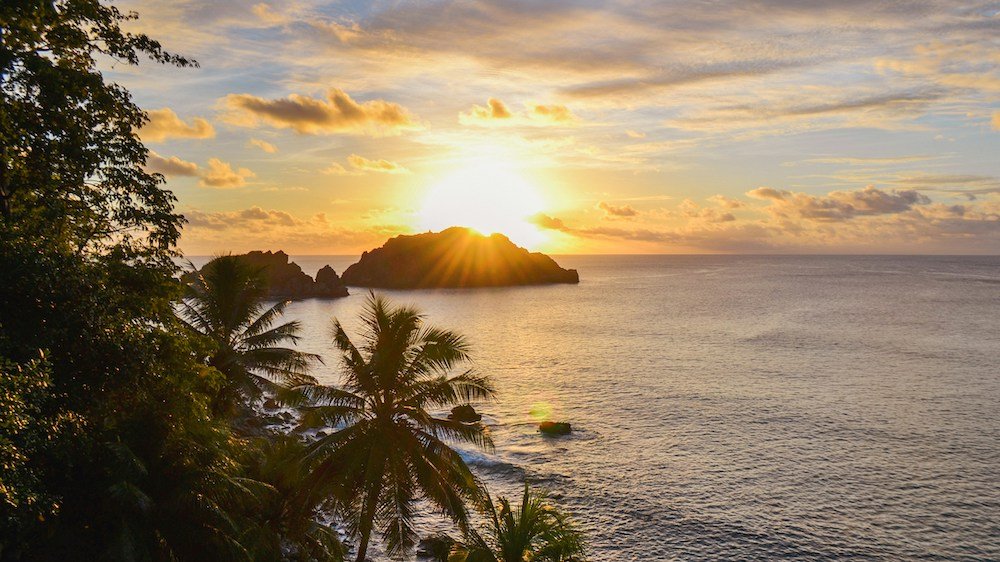
Prepare for your journey to Fernando de Noronha with these practical tips and advice, ensuring a smooth and enjoyable travel experience while staying safe, healthy, and culturally respectful.
Packing essentials for a trip to Fernando de Noronha
Pack wisely for your trip to Fernando de Noronha, ensuring you have all the essentials for a comfortable and memorable stay:
- Lightweight Clothing: Pack lightweight, breathable clothing suitable for warm tropical weather, including swimsuits, shorts, T-shirts, and sandals.
- Sun Protection: Bring sunscreen with a high SPF, wide-brimmed hats, sunglasses, and protective clothing to shield yourself from the sun’s rays during outdoor activities.
- Insect Repellent: Mosquitoes and other insects may be present, especially in wooded areas and during the rainy season. Pack insect repellent to prevent bites and irritation.
- Snorkeling Gear: If you plan to snorkel or dive, consider bringing your own snorkeling gear, including masks, snorkels, fins, and underwater cameras for capturing memorable moments.
- Reusable Water Bottle: Stay hydrated while reducing plastic waste by bringing a reusable water bottle. The tap water in Fernando de Noronha is safe to drink, so you can refill your bottle as needed.
- Travel Documents: Don’t forget to bring your passport, travel insurance, flight tickets, accommodation reservations, and any necessary permits or entry requirements for visiting the island.
Health and safety considerations
Prioritize your health and safety during your stay in Fernando de Noronha by following these important considerations:
- Medical Precautions: Ensure you are up-to-date on routine vaccinations and consider additional vaccinations recommended for travel to Brazil. Consult with your healthcare provider or a travel medicine specialist for personalized advice based on your medical history and itinerary.
- Water Safety: While tap water on the island is generally safe for drinking, consider using bottled water for drinking and brushing your teeth if you have a sensitive stomach.
- Sun Safety: Protect yourself from sunburn and heat-related illnesses by seeking shade during peak sun hours, staying hydrated, and wearing sunscreen, hats, and lightweight clothing.
- Emergency Contacts: Familiarize yourself with local emergency services, medical facilities, and contact information for the nearest consulate or embassy in case of emergencies.
Language and communication tips for travelers
While Portuguese is the official language of Brazil, English is widely spoken in tourist areas, including Fernando de Noronha.
However, learning a few basic Portuguese phrases can enhance your travel experience and facilitate communication with locals:
- Greetings: Learn common Portuguese greetings such as “Bom dia” (Good morning), “Boa tarde” (Good afternoon), and “Boa noite” (Good evening).
- Basic Phrases: Practice simple phrases like “Por favor” (Please), “Obrigado/a” (Thank you), and “Com licença” (Excuse me) to express politeness and respect.
- Local Customs: Familiarize yourself with local customs and cultural norms, including dining etiquette, tipping practices, and social customs, to show respect for the local culture and traditions.
By packing thoughtfully, prioritizing your health and safety, and embracing cultural sensitivity, you can make the most of your trip to Fernando de Noronha while creating lasting memories and meaningful connections with the island’s natural beauty and vibrant culture.
Conclusion
Embark on a journey of discovery and wonder as you explore the breathtaking landscapes and pristine shores of Fernando de Noronha.
From its azure waters teeming with marine life to its rugged cliffs and golden beaches, this remote paradise beckons travelers seeking adventure, relaxation, and natural beauty
Fernando de Noronha captivates the imagination with its myriad attractions and natural wonders:
- Pristine Beaches: Explore the island’s idyllic beaches, including the world-renowned Baía do Sancho and Praia do Leão, where crystal-clear waters and powdery sands await.
- Vibrant Marine Life: Dive into the depths of Fernando de Noronha’s marine ecosystems, where colorful reefs, playful dolphins, and majestic sea turtles await discovery.
- Rich Cultural Heritage: Immerse yourself in the island’s rich cultural heritage and historical landmarks, from colonial-era forts to vibrant local communities.
As you journey through Fernando de Noronha, embrace the spirit of adventure and exploration that defines this enchanting destination.
Whether snorkeling among schools of tropical fish, hiking along scenic trails, or savoring local cuisine at seaside eateries, every moment on the island is an opportunity for discovery and delight.
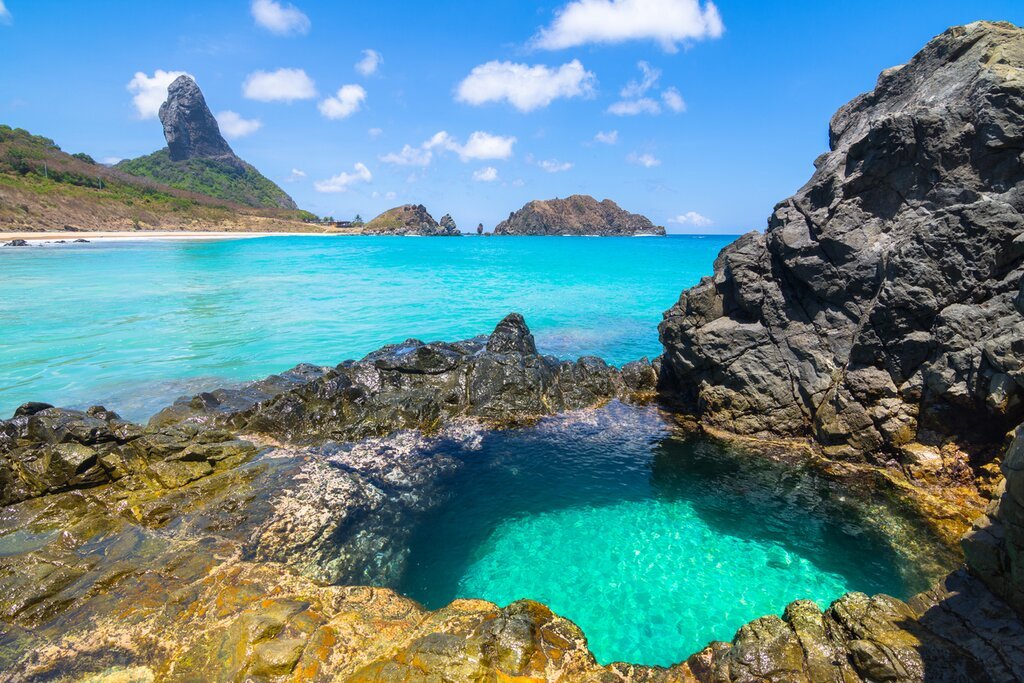
FAQ’s About Fernando De Noronha:
Why is Fernando de Noronha so expensive?
Fernando de Noronha’s high cost of living and travel expenses can be attributed to several factors.
Firstly, the island operates under strict environmental preservation regulations, limiting the number of visitors and commercial activities to protect its fragile ecosystems.
Additionally, transportation costs, including flights and boat transfers, contribute to the overall expense of traveling to and within the archipelago.
Limited infrastructure and the need to import goods also drive up prices for accommodations, dining, and activities on the island.
Is it safe to go to Fernando de Noronha?
Fernando de Noronha is generally considered a safe destination for travelers.
The island maintains a low crime rate, and violent crime is rare.
However, visitors should exercise common sense precautions, such as safeguarding valuables, avoiding isolated areas after dark, and adhering to local laws and regulations.
Additionally, it’s essential to respect the natural environment and heed safety guidelines, particularly when engaging in water-based activities like swimming, snorkeling, and diving.
How do you get to Fernando de Noronha?
The primary mode of transportation to Fernando de Noronha is by air.
Regular flights operate from major Brazilian cities such as Recife and Natal to Fernando de Noronha’s airport.
Gol Linhas Aéreas is the main airline serving the island.
Due to environmental restrictions and limited flight availability, it’s advisable to book flights well in advance, especially during peak tourist seasons.
What is the meaning of Fernando de Noronha?
The name “Fernando de Noronha” honors the Portuguese nobleman Fernão de Loronha, who likely financed early explorations to the island in the 16th century.
The Portuguese navigator and explorer Amerigo Vespucci first documented the island’s existence during his voyage in 1503.
What is special about Fernando de Noronha?
Fernando de Noronha is renowned for its pristine natural beauty, vibrant marine ecosystems, and protected status as a UNESCO World Heritage Site.
The archipelago boasts crystal-clear waters, secluded beaches, and diverse marine life, making it a paradise for snorkeling, diving, and eco-tourism enthusiasts. Its strict environmental regulations ensure the preservation of its unique biodiversity and cultural heritage.
Why is Fernando de Noronha famous?
Fernando de Noronha is famous for its stunning landscapes, rich marine biodiversity, and strict environmental conservation policies.
The archipelago’s breathtaking beaches, clear waters, and vibrant coral reefs attract visitors from around the world, while its designation as a UNESCO World Heritage Site underscores its global significance as a natural sanctuary and ecological treasure.
How long should you stay in Fernando de Noronha?
The ideal length of stay in Fernando de Noronha depends on individual preferences and interests.
While some travelers opt for short getaways of three to four days to explore the island’s main attractions, others may choose to extend their visit to a week or more to immerse themselves fully in its natural beauty and cultural offerings.
Ultimately, the length of stay should allow ample time for leisure, relaxation, and exploration of the island’s diverse landscapes and activities.
How many people live on Fernando de Noronha?
Fernando de Noronha is home to a small population of approximately 3,000 residents, primarily concentrated in the main settlement of Vila dos Remédios.
The island’s population includes locals employed in tourism, conservation, and traditional fishing industries, as well as transient workers and expatriates from mainland Brazil.
How do you pronounce Fernando de Noronha?
The pronunciation of “Fernando de Noronha” follows Portuguese phonetics.
In Portuguese, it is pronounced as “Fer-NAHN-doo dee No-ROH-nyah,” with the stress placed on the second syllable of “Noronha.”
